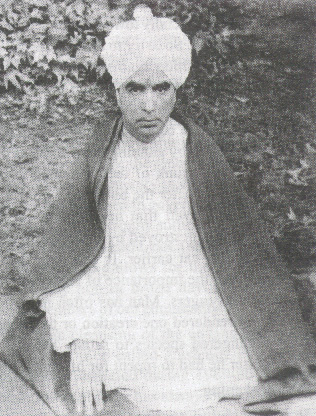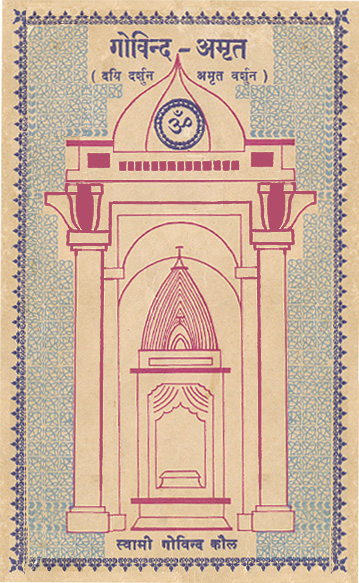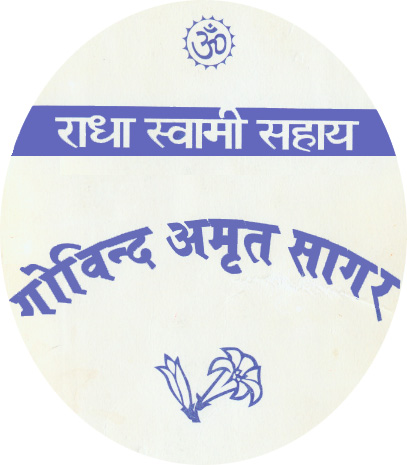Swami Govind Kaul
It is reasonable to believe that a site has some form of consciousness in the same way as the human body has an animating consciousness. It is the outer form of our self that comes into contact with the phenomenal world through the senses which implant thoughts and feelings in our consciousness. The site and the self thus interact with each other imperceptibly in a significant way. To one such site of our blessed valley of Kashmir belonged Gobind Kaul. The place is popularly known as Vanpoh in Anantnag, which in earlier times must have been a beautiful meadow in the close vicinity of a forest fragrant with wild flowers and therefore originally called Vana-Posha. The son of Swami Aftab Kaul and Vishvamalya, born in Dattataraya Gotra, Gobind Kaul naturally followed the tradition of his forefathers and became an ardent Shaivite. To his elder brother Harishwara and to his Guru Bharatlal he owed his proficiency in the Sastras andyoga. His association with other saints, particularly Swami Krishanjoo Razdan (his maternal uncle, who was a celebrated poet of his time), and their impact on him are evident from his 'rosary of hymns' (bhajanmala), published under the title Gobind Amrit. Tankodi Chandra (Sant of Varanasi), Sant Lal of Shahpur and Swami Rama (looked upon by his devotees as the Sakshat Shiva) of Kashmir, besides other Pranyogis and Jnanayogis of his time, showered many benedictions on him. (Poem No. 8, Shiva Lagyo, pp.10-11).
 Swami Govind Kaul
Swami Govind KaulHis devotional lyrics reveal that he was deeply influenced by the thought-current of Mansurul-Halaj as well and he freely used the popular idiom of his own Kashmiri dialect, being a blend of Sanskrit, Persian and Arabic. His songs are rich in imagery, and the vocabulary he employees to convey his inner experiences suggests, unmistakably, how he too must have followed the same spiritual path that Lalleshwari had treaded several centuries before him.
We notice that the devotional strain is marked in Gobind Kaul's lyrics, from which we infer that it was as a devotee that he began his spiritual journey to the Divine and in course of time, through sustained devotion and sadhana, attained Self-realization. He is so much devoted to Gopala Bala Krishna that he loses the consciousness of his limited self in his bout of 'lolamasa' (love-drink). He offers himself wholly to his rasalila (sport of love) involving measured movements of the body. Beside himself with joy, he would like to accompany Balakrishna in his ramblings on the bank of the river Yamuna and give his all to kissing his feet (moni-padan). He hears the sound of Om from his flute and wishes to play rasa in all forms with him. All the time the sound of Om reverberates and he perspires profusely at the sight of his lover's hair (poem No. 27 'Shyam-Sunderah..... p. 31) that Manmohan gets complete hold of his mind, and he feels charmed ! Rukmani could not see Cidanand (consciousness - bliss) as something different from Caitanya Krishna and, likewise, Gobind sees the Lord's playing-sites as the very states of wakefulness Yagrat), dreaminess (svapna), and deep sleep (Susapti). In the ocean of divine knowledge (jnana) and bliss (ananda) that Gobind delves deep into, he attains the summit of contemplation (samadhi) (Poem No. 25, 'Satcit-ananda atma Krishnan', pp. 28-29) .Hereth Swami completely identifies himself with his beloved Krishna, offering his all for love - his body, mind, intellect and what not !
The same devotional strain is discernible in the Swami's approach to the divine Mother. The true bhakta finds no flowers or ablations suitable enough to propitiate the Mother, even though he wholeheartedly selects the best ones for her. She represents the primeval energy that pervades all objects; her immanence is felt all around. Bhakti for the divine Mother leads one to salvation (she is muktidayaka). Gobind Kaul, the saint-poet, invokes the all-powerful energy (Sakti) to remove his impediments and lead him to self-recognition. All the jivas (individual beings) and devas (gods) turn to the divine Mother for granting them the boon of final emancipation. She is sat-cit-ananda and dayasyand (sea of Mercy); she is both our father and mother. Addressing her, Gobind says. "You are the atman and the light of Intelligence, of whom the bhakta asks for calm of mind and pure intelligence to overcome the darkness of ignorance." Where the Mother sits in her visible and embodied forms, that place turns into siddha-pitha (seat of success). Those who serve her feet are surely blessed and cured of all worldly ailments and sufferings. (Poem No. 4, 'Om Jaya Bhavinai ...,'pp. 5-6) Gobind Jee enshrines her lotus feet in his heart and taking them as Omkar-bindu, he surrenders himself to the Mother (as Vaikhuri, the Goddess of speech). At her feet, he listens to the sat-sabda (true word). Gobind is suffused with Lola (love) for his Mother, with tears running down his eyes. He invokes her grace for gaining admittance into her abode - all the hurldes from top to bottom being removed - so that he is united with the Transcendent. She is Gayatri, Savitri, Sarasvati, Rajna, Omkara as also Amba, Uma, Durga, Tripura, Sarika, Hari. She is pure, without duality, and Sat-cit-Ananda (Poem No. 2, 'Saran Amate...... pp. 2-3). She is the dynamic aspect of the Absolute and the real object of worship. Obviously, the worship of Sakti forms an essential element of the Saiva aspirant's sadhana. That explains why Gobind meditates and contemplates upon the Sakti (dynamic) aspect of the Absolute.
When we talk of Gobind's devotion to the holy Mother, we, in fact, refer to the ever dynamic inunanent aspect of the Divine. Siva is the Absolute/ Brahman Parmesvara, in His transcendent aspect. Adorned with the crescent moon and bearing matted locks of hair, Mrtyunjaya Gangadhara, carrying the trident and damaru in his hands, Gobind believes that He would keep him ever awake with the sound of the damaru and his sat will be stabilized. While chanting the monosyllable Om of love, he will turn the water-mill to steady his japa to produce the sweet suham tune. Gobind prays: "May the sun of Dvadasanta Mandala shine forth within and outside myself." He praises Siva as the light of pure Consciousness whose grace the devotee seeks, and also earnestly seeks the Yogesvara's help in having a spiritual bath in the Mansarovara (the tranquil lake of the mind) like the fabled swans 'that can sift milk from water': representing the highest state of consciouness that Parmahamsas (like Sri Rama Krishna) are believed to atain as embodied human beings. Gobind invokes the skullbearer, white Spotless Sankara to bum his very marrow as his oven of love is fully ablaze. To Him, stationed in the temple of his heart, he would offer the flowers of love in worship. He naturally regards love as the very fountain-head of spirituality, the very source and culmination of life. He pins his hopes on Sankara, imagining that in his horoscope the planets are ideally positioned in favourable signs - Jupiter in the ninth house, the moon in the kendra, exalted Saturn in Libra. He urges him not to be indifferent to him considering the fact that he had shown mercy and kindness towards Markandeya.
As the devotee's sadhana deepens, the Sadguru draws closer to him. The more he concentrates on his lotus feet, the more resonant does the sound of nada-bind get. He sees the sahasrar (thousand-petal lotus) in full bloom and the divine light all around himself. The sound of Om reverberates as he fondles the Chhanda, the way being shown by the Guru. With his gaze fixed on the ether (akasa), the devotee sees the Lord and the rising sun and the moon in the midst of the shining galaxy of stars. Gobind addresses the spiritual seeker, exhorting him not to get enmeshed in the shackles of Maya but listen to the word of the Guru. For surely once he repeats the five divine names and concentrates his gaze on the Ajna Chakra, the central point between the eyebrows (called brumadya), he will reach the abode of Sadguru (alakh, agam, anamaya). In no uncertain terms the aspirant is instructed to look to Omkara binda. This is what Lord Siva has revealed to his consort, Gauri, in the privacy of perfect solitude. Gobind instructs the sadhak to deepen his attention (what he calls surat) and concentrate it on the sabad till all sounds merge into one and thus Surat Sabda yoga is realized. (Poem No 40 'Guru-dhyana', pp 44-45).
The leitmotiv of Gobind Kaul's bhajans is to identify oneself with Omkara. Like a true Saiva he follows the Guru tradition and in the footsteps of the Guru finds every pore of his being filled with the sound of Omkar and every hair vibrant with it. Gobind encounters an extra-ordinary spiritual experience (Poems 40-44, pp. 44-49). He sees the Light Divine, hears the drum being played upon, the ringing of the bell and sound of the conch, enjoys the charms of the dawn, finds the Beloved seated there, the fairies singing in chorus, the flash of lightening, etc. The eclipse of his sun is gone with the spread of bright sunshine and the moon emerges from behind the clouds. The path of Omkara is verily the path of union with the Absolute. Om is the root but the path is beset with so many pitfalls which the Guru helps the sadhaka to overcome, sifting milk from water and helping him to see the pure luminous self. The Anahat Sabda (unstruck sound) awakens the Jivatma and the night is turned, as it were, into mid-day. Many a secret is revealed to Gobind through the grace of his Guru who opened his 'wooden bolts' from within, what is described as Chakra-bedan in yogic literature. (Poem No. 84, 'sapud jivatma ...,' p. 93).
Every morning Gobind reflects on su and su (Poem No. 72, 'Prath prabhatan,' p. 81) on Om and its resonance, on Sat as su and su. It is ever pure, taintless and free. It is sat-cit-ananda and self-luminous. It is All Absolute (Paripuran). Gobind considers himself lucky to have got the human frame, a thing even the devas pine to obtain as a boon. He has thus been enabled to practise meditation on sat as su su ! The Vedas, Upanishads and Puranas have sought to illuminate the distinction between the questions 'who he is' and "who I am". Gobind says he has reflected on 'su su' in the company of truth seekers, and tasted the divine nectar. He exhorts the sadhaka to enter through the door of the heart (Poem No. 115, 'hradayik darvaza,' pp. 121-122) and listen to zeer (fall) and bam (rise) of the inward music (the sound produced by the yogic practice of pranava. He should be ever wakeful to listen to the anahat sound of Om sabda that signals the dawn of superconsciousness; it serves as it were on the aircraft that carries the sadhak into the higher space (gaganas). Let the sadhak become the royal eagle to traverse the outer space, the dwelling of the famakan (the disembodied being). That is Gobind's instruction to the sadhak.
Gobind lays utmost emphasis on steady and constant spiritual practice that alone ensures success in the path: the spiritual aspirant attains his goal. Every moment of consciousness for the practising seeker ensures the blooming of his heart-lotus accompanied by illumination - rise of the spiritual sun of consciousness. (Poem No. 114. 'Alimai Khotai', pp. 120-12 1). He has to give up his ham (ego) and caress su su, Gobind communicates his spiritual experience to the truth-seeker, enjoining upon him to ascend to the sky of dvadasanta, drink the divine nectar to become nishkal (desireless) and cross the barriers courageously, and not get frightened by the deafening noise enroute. The Guru, he assures the sadhak, will take full care of him. His grace alone would ensure for him the enjoyment of uniterrupted flow of the sound of om: listening to the satsabda day and night accompanied by the experience of inward illumination. Gobind maintains that su su is the source of divine love (lola) that chases away death. As the wise alone can understand and appreciate the art of a florist, so can the yogi understand what su su conveys.
Gobind's state of mind is not difficult to judge. Like other mystic poets, he sings of pain and separation, of joy and fulfillment in the same breath. The Beloved just tempted me, says the mystic, and then abruptly disappeared. This has made him restless and sick. How he longs for the Beloved to return and the bulbul (a song bird) to see the flowers in bloom ! He does not aspire for anything other than the Beloved and has offered to buy his wares as the sole purchaser. He has sacrificed his body and mind to him. He considers the cycle of coming and going (what the word sansar conveys) fierce as a blazing fire and something that nothing can excel in cheating. He is helpless and tears roll down his eyes. He now decides to withdraw himself to the inward melody of omkara which sounds like a guitar.
[The author, Dr. V. N. Drabu, is a well - known scholar in the field of history and an accomplished writer. He lives in Jammu.]
Bhajan Albums
Govind Amrit

Swami Govind Kaul
Amrit Varshun
|
Presented by Dedicated to my Guru Singer |
|







